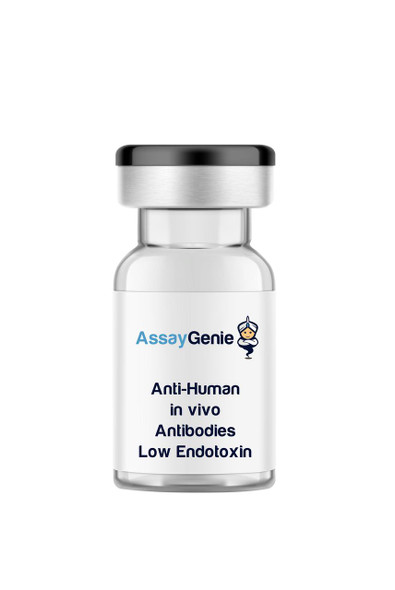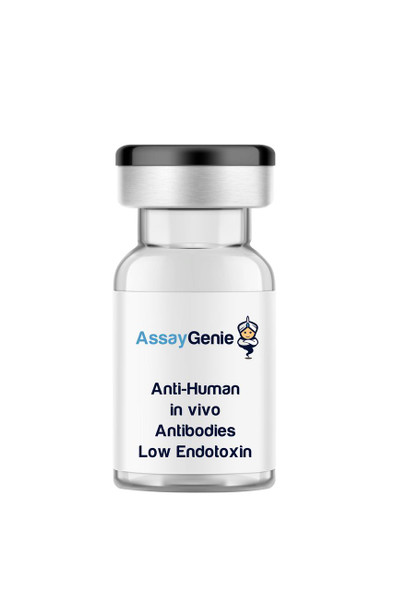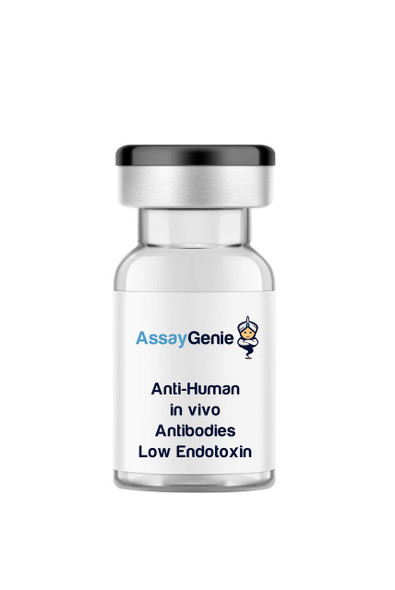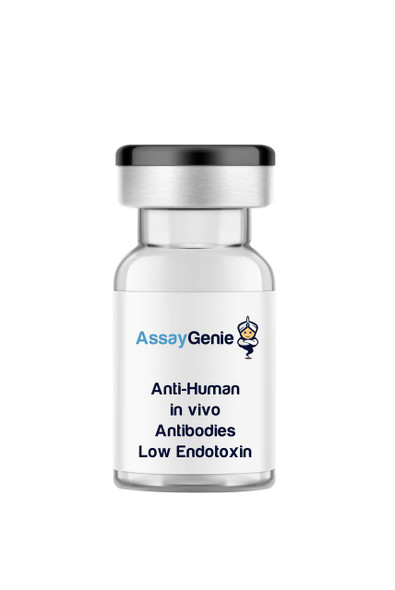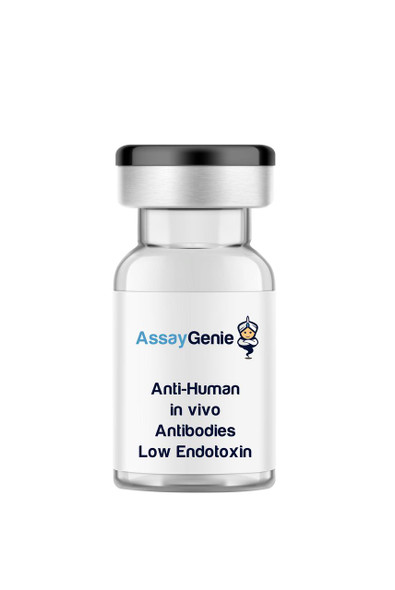Anti-Human Alpha Defensin-5 [8C8] In Vivo Antibody - Low Endotoxin
- SKU:
- IVMB0102
- Product Type:
- In Vivo Monoclonal Antibody
- Clone:
- 8C8
- Protein:
- HD5
- Isotype:
- Mouse IgG2b kappa
- Reactivity:
- Human
- Synonyms:
- DEFA5
- DEF5
- HD-5
- Endotoxin Level:
- Low Endotoxin
- Host Species:
- Mouse
- Applications:
- Dot
- ELISA
- IHC FFPE
- WB
Description
| Product Name: | Anti-Human Alpha Defensin-5 [8C8] In Vivo Antibody - Low Endotoxin |
| Product Code: | IVMB0102 |
| Size: | 1mg, 5mg, 25mg, 50mg, 100mg |
| Clone: | 8C8 |
| Protein: | HD5 |
| Product Type: | Monoclonal Antibody |
| Synonyms: | DEFA5, DEF5, HD-5 |
| Isotype: | Mouse IgG2b κ |
| Reactivity: | Human |
| Immunogen: | Recombinant Human HD5 (aa 20-94). |
| Applications: | Dot, ELISA, IHC FFPE, WB |
| Formulation: | This monoclonal antibody is aseptically packaged and formulated in 0.01 M phosphate buffered saline (150 mM NaCl) PBS pH 7.2 - 7.4 with no carrier protein, potassium, calcium or preservatives added. |
| Endotoxin Level: | < 1.0 EU/mg as determined by the LAL method |
| Purity: | ≥95% monomer by analytical SEC >95% by SDS Page |
| Preparation: | Functional grade preclinical antibodies are manufactured in an animal free facility using only In vitro protein free cell culture techniques and are purified by a multi-step process including the use of protein A or G to assure extremely low levels of endotoxins, leachable protein A or aggregates. |
| Storage and Handling: | Functional grade preclinical antibodies may be stored sterile as received at 2-8°C for up to one month. For longer term storage, aseptically aliquot in working volumes without diluting and store at -80°C. Avoid Repeated Freeze Thaw Cycles. |
| Applications: | Dot, ELISA, IHC FFPE, WB |
| Recommended Usage: | WB ELISA |
| Reactivity: | Human |
| Host Species: | Mouse |
| Specificity: | Clone 8C8 recognizes human alpha-defensin 5 (HD5). |
| Antigen Distribution: | HD5 is highly expressed in the secretory granules of Paneth cells of the ileum. |
| Immunogen: | Recombinant Human HD5 (aa 20-94). |
| Concentration: | ≥ 5.0 mg/ml |
| Endotoxin Level: | < 1.0 EU/mg as determined by the LAL method |
| Purity: | ≥95% monomer by analytical SEC >95% by SDS Page |
| Formulation: | This monoclonal antibody is aseptically packaged and formulated in 0.01 M phosphate buffered saline (150 mM NaCl) PBS pH 7.2 - 7.4 with no carrier protein, potassium, calcium or preservatives added. |
| Preparation: | Functional grade preclinical antibodies are manufactured in an animal free facility using only In vitro protein free cell culture techniques and are purified by a multi-step process including the use of protein A or G to assure extremely low levels of endotoxins, leachable protein A or aggregates. |
| Storage and Handling: | Functional grade preclinical antibodies may be stored sterile as received at 2-8°C for up to one month. For longer term storage, aseptically aliquot in working volumes without diluting and store at -80°C. Avoid Repeated Freeze Thaw Cycles. |
The colon lies adjacent to the small intestine and has heavy bacterial colonization from ingested food and water that is often contaminated with bacteria. Remarkably, the small intestine has a low microbial density. A special type of epithelial cell, called a Paneth cell, can be found clustered at the base of the tubular glands that lie between the villi of the inner surface of the small intestine. These cells secrete defensins which have been shown to have activity against both Gram-positive and Gram-negative microbes.3 Six human α-defensins, a subfamily of defensin peptides characterized by their cysteine spacing and disulfide connectivity2, have been identified. Human Paneth cells express α-defensin 5 (HD5) along with HD6. Paneth cells are most numerous in the ileum and have many features similar to those of myeloid cells. They are multifaceted cells with a large quantity of apically-located eosinophilic secretory granules containing lysozyme and other antimicrobial factors which are released upon bacterial stimulation.2 In addition, these cells express tumor necrosis factor alpha (TNF-a), CD1, and CD15.1 Paneth cells do not store defensins as fully processed or active peptides, rather they store them as inactive propeptides.2 They are released as mature peptides after trypsin digestion. Trypsin is also secreted from the Paneth cell granules. It has been reported that disrupted α-defensin processing in murine Paneth cells has initiated a vulnerability to enteric infection.2 HD5 expression levels have been found to be negatively correlated to intestinal infection. Additionally, studies have shown HD5 to be a strong antagonist towards human Papillomavirus infection. Furthermore, low expression of HD5 is thought to play a role in Crohn’s disease.3 Anti-Human Alpha Defensin-5 (HD5) Clone 8C8 has been shown to recognize the propeptide and the partially processed forms of HD5. However, clone 8C8 has been reported to scarcely recognize the mature peptide. There was no reported cross reactivity with HD6, lysozyme, or sPLA2.
| Technical Datasheet: | View |
| Protein: | HD5 |

| Mouse IgG2b Isotype Control | |
|---|---|
| Clone | MPC-11 |
| Isotype | Mouse IgG2b kappa |
| Endotoxin Level | Low Endotoxin |

![Anti-Human Alpha Defensin-5 [8C8] In Vivo Antibody - Low Endotoxin Anti-Human Alpha Defensin-5 [8C8] In Vivo Antibody - Low Endotoxin](https://cdn11.bigcommerce.com/s-39x6lpnvxv/images/stencil/608x608/products/119850/118033/anti-human-alpha-defensin-5-8c8-in-vivo-antibody-low-endotoxin__64426__79225.1698937743.jpg?c=1)

